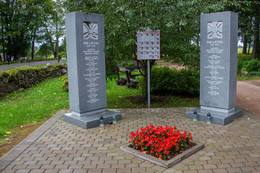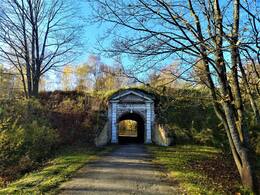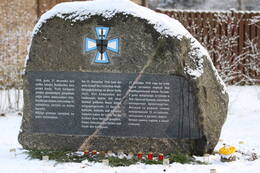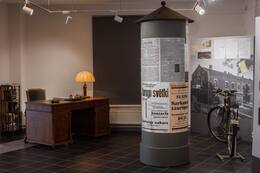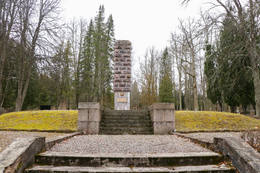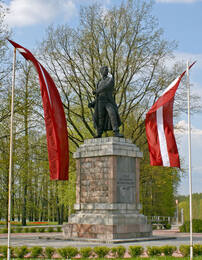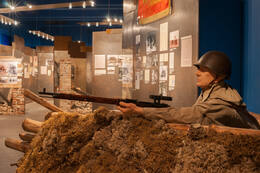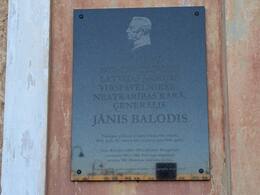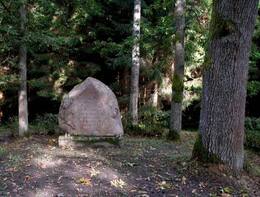Jānis Balodis (1881-1965), Commander-in-Chief of the Latvian Army, Minister of War, General
I World War I, I Wars of Independence, II World War II, IV Soviet Occupation
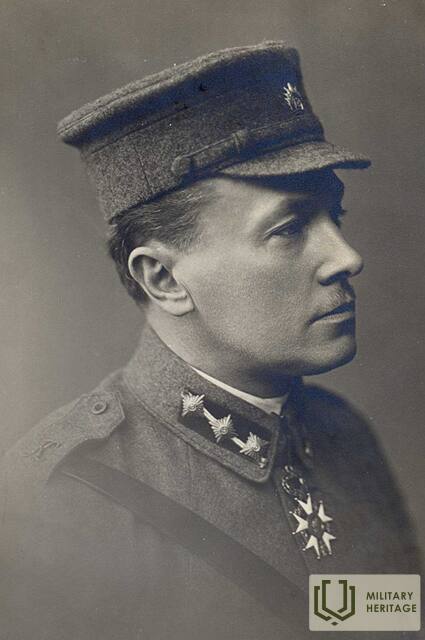
Jānis Balodis was born on February 20, 1881 in “Vēženiekis” in Trikāta parish. After graduating from Trikāta parish school in 1898, he voluntarily joined the Russian army, serving in Kaunas in the 110th Kama Infantry Regiment. After graduating from the Vilnius Junkers School in 1902, J. Balodis was promoted to lieutenant colonel and assigned to the 100th Ostrova Infantry Regiment. In 1905, he participated in the Russo-Japanese War, and after it ended, he continued his service in the 106th Ufa Infantry Regiment in Vilnius.
During World War I, in February 1915, Captain Jānis Balodis was wounded near Grodno and taken prisoner by the Germans. After returning from captivity, J. Balodis voluntarily joined the armed forces of the Latvian Provisional Government on December 1, 1918 and became the commander of the Officers' Reserve Company (later the 1st Independence Company). He participated in the first battles near Lielauce, Skrunda and Venta. On February 28, 1919, for his combat merits, he was promoted to major general (lieutenant colonel). After the death of Colonel Oskars Kalpaks, Jānis Balodis was appointed commander of the 1st Latvian Separate Battalion (later brigade), and soon after – on March 21, 1919 – he was awarded the rank of colonel.
After the Battle of Cēsis, when the North Latvian Brigade entered Riga on July 6, 1919, and the two groups merged into one national army, Balodis was appointed commander of the newly formed 1st Courland Division and thus also the commander of Latvian troops on the Eastern Front. In this position, he carried out offensive operations in Latgale. On October 16, 1919, he was appointed Commander-in-Chief of the Latvian Army. Under the leadership of Jānis Baložs, the small Latvian army, with the support of neighboring countries, defeated and expelled the Bermontites, then in early 1920 defeated the Bolsheviks in Latgale. On January 23, 1920, he was awarded the rank of general. In March 1921, Balodis was dismissed from his position due to its liquidation and the army's transition to a peacetime staff list. On July 1, 1921, he retired from the army at his own request. After the end of his military career, General J. Balodis became involved in politics, becoming a deputy of the Saeima of the Republic of Latvia from 1925 to 1934. On October 26, 1925, he was appointed a member of the Council of the Lāčplēsis War Order.
Jānis Balodis was awarded all three classes of the Lāčplēsis War Order, as well as many foreign awards. For his services to the country, he was granted the Baloži farm (formerly Upesmuiža) in Līvbērze parish as his ancestral property.
On December 7, 1931, J. Balodis was appointed Minister of War. He actively participated in the coup d'état of May 15, 1934, carried out by Kārlis Ulmanis. In accordance with the law of March 12, 1936, Balodis was appointed as the President of the Republic in cases provided for by law.
During the Soviet occupation, in July 1940, he was arrested and deported to Syzran with his wife, where he lived under the supervision of security authorities. In 1941, as World War II unfolded in the territory of the USSR, Balodis was arrested and placed in Kuibyshev prison. In 1946, he was transferred to Ivanovo prison, but in March 1952, he was sent to Vladimir prison.
Jānis Balodis was released from prison in 1956 and returned to Latvia with his wife. He lived in Saulkrasti, where he died on August 8, 1965. He is buried in Riga, at the I Meža Cemetery.
More information sources
Ēriks Jēkabsons. Jānis Balodis. – National Encyclopedia: https://enciklopedija.lv/skirklis/29969-J%C4%81nis-Balodis
Jānis Balodis. Memoirs. 1918–1939. year, comp. A. Caune, Latvian Institute of History Publishing House, Riga, 2015.
Andris Caune. General Jānis Balodis in Russian Exile and Prison, 1940–1960, Latvian Institute of History Publishing House, Riga, 2016.
The last years of General Jānis Baložs' life in Latvia, 1956–1965, memories and testimonies of contemporaries, comp. A. Caune, Riga, Latvian History Institute Publishing House, 2014.
Biography of Jānis Baložs, Cavalier of the Lāčplēsis War Order: http://lkok.com/detail1.asp?ID=2141
Related timeline
Related objects
Memorial sites of generals and knights of the Lāčplēsis Military Order in Trikāta parish
The memorial stele is located next to the Trikāta cemetery chapel.
The Trikāta cemetery preserves the memory of three outstanding Latvian generals - Roberts Dambītis, Kārlis Goppers and Jānis Balodis. The teacher of all these generals, Jēkabs Mūrnieks, is also buried in the Trikāta cemetery, for whom a monument made of travertine, modeled after Kārlis Zāle, was erected at the burial site in 1928.
The generals and knights of the Lāčplēsis Military Order are commemorated every year with torchlight processions to the Trikāta cemetery, where there are two memorial steles, in which a total of 17 names of knights of the Lāčplēsis Military Order associated with the Trikāta parish are engraved.
The stele was unveiled on November 11, 2018.
Video about the Lāčplēsis War Order and a set of orders that belonged to General Jānis Balodis.
Daugavgrīva Fortress
Daugavgrīva Fortress (entry from Birzes street) is located on the Daugavgrīva Island where Buļļupe river joins the Daugava river. The fortress was built in the 17th century to defend from enemies moving in the direction of Riga, which was an important administrative, trade and production centre. Later it became the main fortification of the Latvian Army coastal defence with several support points. This defensive fortification system is one of the most valuable objects of Latvia's military heritage. This fortress has witnessed Latvian military history. For example, during the Crimean War (1853-1856) Latvian and Estonian gunboat crews were trained here. The main objective of these units was to protect local ports and the coast from attacks by the British navy. During World War I Daugavgrīva militiamen companies were formed here. These were the first Latvian combat units, which came even before the Latvian Riflemen. Nowadays it is possible to see the territory of the fortress. ‘Komētforts’ and the Seaside Nature Park are located nearby and Mangaļsala fortifications are on the other side of the Daugava river.
Monument to the first battle for Latvia's independence
Located in Inčukalns, Atmodas Street 2.
On July 3, 2016, a monument to the first battle for Latvian independence was unveiled, dedicated to the Latvian Landeswehr (Die Lettländische Landeswehr), in which local Baltic Germans, Russians and Latvians, who were in units on both sides at the time, defended the newly founded state against the Bolshevik Red Army. Eižens Upmanis, the chairman of the Brothers' Graves Committee, concluded at the time that this could be the first monument to the combined Latvian and Baltic German forces in battle memorials outside the cemeteries. At that time, Lieutenant Colonel Oskars Kalpaks was appointed commander of the Latvian units of the Latvian Landeswehr, from whose units the later Latvian Army grew and formed during the Freedom Struggle.
In 1918, the entire territory of present-day Latvia had fallen into the hands of the German Empire and its troops. However, in the late summer and autumn of 1918, the situation began to rapidly turn against Germany and it was clear that it was only a matter of time before Germany would be forced to admit defeat in World War I. The Russian Empire, which Latvia was part of until World War I, had ceased to exist earlier, with the February and October revolutions of 1917. On 18 November 1918, the Republic of Latvia was proclaimed. The German army, which was located in the territory of Latvia, after the armistice with the Entente powers on 11 November 1918, was no longer motivated for further hostilities and most of its soldiers simply wanted to return to their homeland.
Under such circumstances, it was clear that the defense of Latvia depended primarily on a national guard formed by the Latvian population itself. Initially, due to their education and relatively greater ability to self-organize, the Baltic Germans living in Latvia showed the greatest initiative in forming such a national guard. Russian soldiers also joined the national guard. In order to ensure the supply of the national guard with uniforms, weapons and other necessary resources, the Latvian Provisional Government concluded an agreement with the German representative Augustus Vinnig on December 7, 1918, providing for the provision of the national guard from the German army reserves located in the territory of Latvia. This agreement indicated, among other things, that this national guard, with the official name “Latvijas zemessardze” or in German – “die Lettländische Landeswehr”, would be the armed forces of the Republic of Latvia.
The Latvian National Guard was confronted by two Latvian Red Riflemen regiments (i.e., approximately 2,000–3,000 soldiers) that had previously been experienced in World War I and the Russian Civil War. Despite the Red Army's experience and numerical superiority, the Latvian National Guard held Inčukalna in fierce battles for two days, until finally, on the evening of January 1, 1919, in order to avoid encirclement, it was forced to retreat, losing 43 killed and several wounded, most of whom were captured by the Bolsheviks, where they were killed or died of hunger or disease.
Author: Artis Buks. Material: Fieldstone. The monument is made of a large monolithic stone that was found in Ruļļi near Jelgava.
Exhibition "Latvian Army in Pļaviņas in the 20th Century."
Located at Odzienas Street 2, Pļaviņas.
The permanent exhibition "Latvian Army in Pļaviņas in the 20th Century" is on display.
The building in Pļaviņas, at Odzienas Street 2, has a long history – from the time when the Stukmaņi wholesaler Hugo Apeltofts began active economic activity there, thus contributing to the development of the city of Pļaviņas, to the moment when the headquarters of the Latvian Eastern Front was established here during the War of Independence. In 1919, it was from Pļaviņas that the operations of Latvian army units against the Red Army in Latgale were led.
In 1934, a memorial plaque was unveiled near this house with the inscription: “In 1919, the Eastern Front headquarters was located in this house, and here General Jānis Balodis assumed the supreme command of the Latvian National Army.” The Soviet government removed and destroyed it in 1940, but on June 16, 1990, with the support of the Pļaviņa branch of the Latvian National Liberation Army, it was restored.
Now, near the former headquarters building, there is a memorial stele dedicated to the 15 knights of the Lāčplēsis War Order born in the Pļaviņa region, and an exhibition "The Latvian Army in Pļaviņa in the 20th Century" has been created inside the premises, which tells about the events during the Freedom Struggles, the activities of the headquarters of the 3rd Latgale Division of the Latvian Army in Pļaviņa, and also provides an insight into the life stories of the knights of the Lāčplēsis War Order.
Not far from the exhibition building is the Latgale Division Headquarters building, which was built in 1913 as the Stukmanu liqueur factory by Count Teodors Medem. In 1919, it was taken over by the P. Stučka regime, where it had also established a prison. After the Bolsheviks were expelled, the building was taken over by the Latvian Army in 1925, which housed the Latgale Division Headquarters. 10 generals and other officers of the Latvian Army spent their military careers in this building. In 1940, the building was taken over by the Red Army. In the post-war years, it housed a school, as well as the municipality. Around 1970, the building began to be used by the production association “Rīgas Apērbs”.
Visiting the exhibition must be booked in advance by calling T. 28442692.
Monument to the members of the Tirza congregation who fell in the freedom struggle
Found in the Tirza Kancēns cemetery.
A monument with a lion's head is visible.
A monument made of chipped boulder stone, designed by architect Aleksandrs Birzenieks and sculptor Vilhelms Treijs, commissioned by the Tirza branch of the Brethren Cemetery Committee, and made by stonemason Blumbergs. The monument was built with funds donated by members of the Tirza parish and the Brethren Cemetery Committee. 2,377 lats were donated to the monument fund. Unveiled on September 9, 1928.
The monument is made of massive granite blocks in the form of a square column and leaves the impression of a symbol of strength and independence. The bronze parts and decorations of the monument were created by sculptor Vilhelms Trejs. Material: granite, bronze, form: architectural composition with copper forgings. On one side of the monument there is a bronze lion's head and a plaque with the inscription: "In this holy place the virtue of good men has created a spiritual dwelling for itself.". On the other side it is written: "In eternal memory of the sons of the Tirza parish who fell in war and freedom struggles. Anno 1928.".
It is known that the monument was consecrated at the opening ceremony on September 9, 1928, by the reverend Edgars Bergs. The legendary General Jānis Balodis, who is an outstanding figure in Latvian history, also participated in the opening ceremony. He was the commander-in-chief of the army in the battles against the Bermontites and the Red Army in Latgale. After the coup d'état of 1934, he was the second person in the country and remained so in the people's memory even after 1940.
In 2008, the monument was restored with the help of the Tirza Development Association.
Monument to the fallen soldiers of the Latgale Partisan Regiment 1919 - 1920
During the Latvian War of Independence (1918-1920), the Balvi Partisan Division was formed in the Balvi region on the initiative of local residents, which was soon transformed into the Latgale Partisan Regiment.
The idea for a regimental monument arose as early as 1927. In 1933, former Latgale Partisan Regiment soldier and stonemason Jānis Pilmanis built a 5-meter-high stone pedestal for the monument at his own expense. The bronze monument itself was created by artist Kārlis Jansons.
The monument dedicated to the memory of the fallen soldiers of the regiment was unveiled on August 14, 1938, with the participation of General Jānis Balodis. Although the official name of the monument was “Guarding Partisan”, the people soon simply called the monument “Balva Stanislava”.
After Latvia was occupied by the USSR, the monument was demolished in the spring of 1941 by decision of the Abrene County Executive Committee. The high pedestal was demolished, but the bronze monument itself remained in the Balvi police yard.
During the German occupation, the monument's pedestal was not restored, but the bronze monument itself was placed in its previous location. After the second return of the Soviet occupiers in 1944, the monument was completely destroyed.
When Latvia regained its independence, the people of Balvi collected donations for the restoration of the Latgale Partisan Monument. On November 11, 1993, the restored monument by Andrejs Jansons, son of artist Kārlis Jansons, was unveiled in Balvi.
An additional commemorative plaque was added to the back of the monument's pedestal with the text "Renovated also honoring the Latgale national freedom fighters of 1940-1954."
Latvian War Museum
The Latvian War Museum is located in the Old Town not far from the Freedom Monument in a historic defence building called the ‘Powder Tower’. There are 11 exhibits in the museum. There are various weapons, documents, uniforms, awards, badges and other items detailing the everyday life of a soldier in war. The Latvian War Museum is one of the oldest museums in Latvia. Its origins can be found in World War I. Museum’s collection was made up mainly of personal items of soldiers or items found on battlefields. After Latvia gained its independence the main goal of the museum became to create an exposition on the military history of Latvia and the active role of the population in protecting their land. In 1937 the museum was expanded and was technically one of the most modern museums in Europe at that time. The Powder Tower was one of the fortification towers of Riga. Some evidence dates back to 1330 where it has been mentioned as the ‘Sand Tower’. The tower was destroyed in 1621 when Riga was besieged by the Swedish Army. But in 1650 a new tower for storing gunpowder and weapons was built. After the city’s fortifications were taken down, the Powder Tower remains as one of the most important pieces of evidence of the Riga defence system.
Memorial plaque dedicated to the Commander-in-Chief of the Latvian Army Jānis Balodis
Located in Daugavpils Fortress, on the wall of the building, opposite the parking lot.
A memorial plaque says that in this house (there were officers' houses on Oficieru Street) lived the Commander-in-Chief of the Latvian Army during the War of Independence – General Jānis Balodis (1881-1965). The memorial plaque with the following text was unveiled in the interwar period – on September 29, 1936, when the Latvian Army was located in the Daugavpils Fortress.
It was removed after 1940, but was reinstalled in 2020 by the Daugavpils Heritage association.
Memorial stone at the battle site of General Jānis Baložs' brigade
The memorial stone at the site of the battle of General Jānis Baložs' brigade is located in the forest near the Riga - Liepāja (A9) highway, near the Batari house.
The memorial stone was unveiled in 1936 with a solemn ceremony attended by the then Minister of Transport B. Einbergs and other high-ranking Riga officials and the public of Džūkste parish, commemorating the battle that took place here on March 22, 1919. The inscription engraved on the monument reads: “Here, on March 22, 1919, the battle of the 1st Separate Baloži Brigade took place, in which 10 soldiers fell and 28 were wounded.”
The battle took place between the Separate Latvian Brigade and the 10th Soviet Latvian Rifle Regiment, which consisted of 90 percent Latvians. During the freedom struggle, it was one of those battles in which Latvians fought against Latvians. The Bolsheviks had established themselves in the Batari houses. They began to fire on the brigade soldiers who were heading in the direction of Kalnciems. As the fire intensified, the brigade deployed for battle. The main burden of the battle was borne by the Separate Student Company and the Latvian Independence Battalion. As the battle dragged on, a platoon of the student company and the newly formed company of Captain E. Graudiņš, while performing a bypass maneuver, collided in the forest with the enemy, who was performing a similar maneuver. In a fierce battle, which in some places turned into close combat, the enemy was defeated. At this time, the German Miller battery assigned to the brigade opened fire on the Batari houses. After artillery fire, the brigade drove the enemy from his positions in a swift attack.
The newspaper “Brīvā Zeme” (18.05. 1936) published the memories of a former fighter: “The brigade’s cavalry had just ridden out into the open, when they were met by heavy enemy fire. After that, it was clear that they were dealing with very strong enemy forces. The battalions, on the orders of General J. Baložs, deployed and began to fight, getting into close combat, as the bayonets of the brigade’s soldiers decided this two-hour battle into a brilliant victory for the Kalpakians. This battle was of great importance, because it leveled the situation on the front, which had become unsafe because of the Germans, and ensured that the Red Riflemen’s regiments no longer entered the Zemgale Plain.”
General J. Baložs' brigade won the battle, losing 10 soldiers, including Kārlis Barons (1900.8.III – 1919.22.III), the grandson of the father of the Dainas, Krišjānis Barons, who is buried in the Riga Brothers' Cemetery. 50 soldiers of the Soviet Latvian Riflemen Regiment fell in the battle.
Exhibition “Latvian Army in Pļaviņas in the 20th Century”
The exhibition dedicated to the creation of the Latvian Army is located in Plaviņas. The building that houses the exhibition has a long history. With the establishment of the Stukmaņi (now Pļaviņas) railway station, the construction of houses began in the area, and one of them, built in 1900, was the house of the merchant Hugo Appeltoft. The building was built as a merchants’ house, but later, it became the birthplace of the Latvian Army.
In July 1919, during the War of Independence, the building was used as the headquarters of the Latvian Eastern Front. On 17 June 1934, to commemorate this event, a memorial plaque was unveiled at the building with the inscription: “In 1919, this house was the headquarters of the commander of the Eastern Front, and here, General Janis Balodis assumed command of the Latvian National Army.” The plaque was restored on 16 June 1990. On 10 June 2019, a memorial statue dedicated to the recipients of the Order of Lāčplēsis born in Pļaviņas region was erected in front of the former headquarters building.
The exhibition displays information stands with historical photographs, maps and information about the establishment of the Latvian Eastern Front Headquarters.
Related stories
The life of General Jānis Baložs after his return from exile
When in 1940 the Russians tried to squeeze a favorable military base agreement from the Latvian government, which would make the Latvian army's ability to resist the Red Army almost impossible, General J. Balodis tried to get some amendments to the agreement. However, this did not work. But the general's detractors used this circumstance to later make J. Balodis almost a traitor. After a conflict with the Prime Minister and State Minister K. Ulmanis, the general was dismissed from the post of Minister of War on April 5, 1940. Then J. Balodis decided to participate in the Saeima elections from the Democratic Bloc, but nothing came of it, because only one list was allowed to run in the elections - the list of communist candidates. Latvia became the 14th Soviet republic.
In memory of Oskars Kalpaks
The memory of Oskars Kalpaks is preserved in many places – this is evidenced by his native Liepsalu house, a monument in the Visagala cemetery, commemorative events and beautiful concerts on March 6, the Meirānu Kalpaks Elementary School, streets in Lubāna, Madona and other cities, and on and on. But in this article – about the preservation of the memory of Oskars Kalpaks in his native region in the 1920s–1930s.
The beginning, course and conclusion of the Battle of Cēsis
The victory in the Battle of Cēsis was destined to become a turning point in the Latvian and Estonian struggle for the independence of their country. This victory put an end to the plans of the Andrievs Niedra government and the German general Rüdiger von der Goltz to conquer the Baltics. Instead, the Latvian Provisional Government of Kārlis Ulmanis resumed its activities in Liepāja.
In memory of Pēteris Radziņš, general of the Latvian Army, two-time Cavalier of the Lāčplēsis War Order
General Pēteris Radziņš was born in Lugaži parish, Valka district, into a simple farmer's family, where he learned to do field work. He was a very smart young man, after graduating from school he decided in favor of war and thus began his army career, saving Latvia from Bermont's troops. P. Radziņš was one of the most outstanding officers of the Latvian army and was awarded numerous Latvian and foreign orders and commemorative signs.
Par Sudrabkalniņa atklāšanas svētkiem
Ištrauka iš prisiminimų istorijos iš generolo Jāņo Baložo kalbos Sudrabkalninio paminklo atidengimo dieną. Visas tekstas yra atidarymo renginio atpasakojimas, prezidento Kārlio Ulmanio ir generolo Jāņo Baložo kalbos. Prisiminimai pasirinkti, nes juose vaizdingai matyti Sudrabkalnino apylinkėse kovojančios Latvijos kariuomenės būklė.
Ball Mountain
Bumbu Hill is a high hill in the Bolderāja dunes, Kleistu Forest, Riga. A memorial site for the Latvian Freedom Struggle. During the Bermontiades in November 1919, the command post of the Latgale Division led by Krišjānis Berķis was located here. The 6th Riga Infantry Regiment, attacking from Bumbu Hill, captured Sudrabkalniņš. A memorial plaque was installed in 1939, which was destroyed in 1969. The memorial site was restored in 1989.
About the lesser-known works of Latvian sculptor Kārlis Zāles in the old cemeteries of Dīvala and Trikāta
One of the little-known works of sculptor Kārlis Zāle (1888-1942) is the travertine sculpture "Fallen Roses", created between 1939 and 1940, and associated with the creation of the Brothers' Cemetery ensemble.








